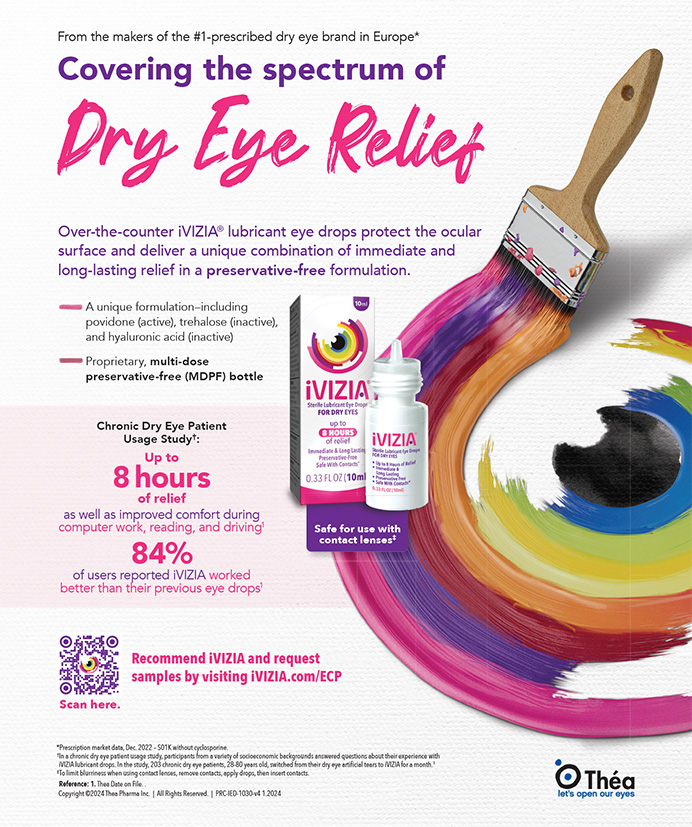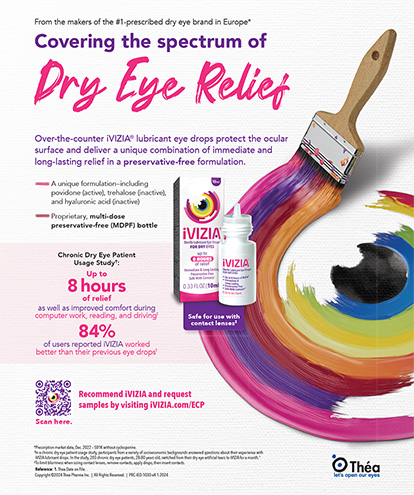
Nicole R. Fram, MD
"Genetic testing and guidance for surveillance are growing in popularity among all specialties of medicine. However, more information without a clear treatment strategy can create anxiety rather than empowerment for patients and physicians. Genetic information is most valuable when there is a clear clinical application and treatment path.
AvaGen (Avellino) evaluates the risk or presence of keratoconus and other corneal genetic disorders caused by gene variants. In my practice, the test has been particularly valuable in the context of screening patients and their family members for keratoconus. Specifically, there are two scenarios where this testing has become invaluable to our patients: (1) refractive surgery evaluations and (2) keratoconus screening for patients and their family members to assess the need for and timing of CXL.
Refractive surgery patients can present with suspicious corneal topography and/or pachymetry findings that may cause a surgeon to choose PRK over LASIK or avoid laser vision correction altogether. Genetic testing assists me with decision-making, so I don’t have to rely on a gut feeling to guide treatment. I don’t screen every refractive surgery patient with genetic testing, but it has helped me decide whether to choose PRK over LASIK or avoid both and consider implanting an Evo Visian ICL (STAAR Surgical) in borderline cases.
Many patients with keratoconus referred for CXL exhibit a difference in disease severity between eyes and are of various ages. Using AvaGen to screen patients for a relative risk score has helped me determine the urgency for CXL or surveillance in the otherwise normal contralateral eye. Similarly, patients have appreciated the ability to screen family members and intervene when necessary.
The main caveats with keratoconus screening are that it is polygenic testing and that risk scores may need time to develop specificity as more data are collected. As we test more patients and grow the database, AI can be applied, providing the granularity necessary to make meaningful decisions and guide our treatment.”
- Private practice, Advanced Vision Care, Los Angeles
- Financial disclosure: Consultant (Avellino)

Sumit “Sam” Garg, MD
"Our practice is just getting started with genetic testing for keratoconus and corneal dystrophies. So far, we have used the test in cases where more information may help us make a therapeutic decision. For example, having another data point for patients who might not be ideal candidates for LASIK can help determine the best course of action (versus no intervention). Additionally, I think there is significant value in risk stratification for the siblings and children of patients diagnosed with keratoconus. If the genetic test indicates a high genetic propensity for keratoconus in these patients, it is extremely important to educate them about the progressive nature of the disease and the possible need for CXL. Overall, I am looking forward to seeing how we can use genetic testing to help us better stratify the risk for keratoconus in and educate our patients on keratoconus and corneal dystrophies.”
- Vice Chair of Clinical Ophthalmology; Medical Director; Director of Technology; and Professor of Cataract, Corneal, and Refractive Surgery, Gavin Herbert Eye Institute, University of California, Irvine
- Financial disclosure: Consultant (Avellino)

Mitchell A. Jackson, MD
"I’m using genetic testing as one step further in the pipelines of diagnostic testing and refractive evaluation to help make a better decision on what I should do for patients in the long term. There are two uses for the AvaGen genetic test for keratoconus and corneal dystrophies in practice. One is for testing the children and siblings of patients with known keratoconus. I recommend that immediate family members come into the practice to review their results and for baseline imaging and evaluation. If they have a high risk of keratoconus, I may recommend CXL. The other use of genetic testing in my practice is for patients interested in refractive surgery. A percentage of the population has a genetic predisposition to corneal dystrophies without showing clinical signs. Genetic testing is a value-added test that could catch this additional risk factor and alter the patient’s treatment course for the better. Incorporating genetic testing into my practice required an alteration in my treatment algorithm. A patient’s genetic risk score for developing keratoconus now factors heavily into my treatment decision. If a patient’s risk score is 20% or less and imaging is normal, I will likely stick with the original LASIK or SMILE plan. On the other end of the spectrum, if their risk score is 90% to 100%, I will not operate. Instead, I monitor them or suggest the Evo Visian ICL or another noncorneal refractive surgery procedure. Decision-making gets more complicated for patients whose risk score is in the middle—the 40% to 70% range. For these patients, I usually take the treatment one step down. For example, if imaging is normal, there’s no family history of keratoconus, their BCVA is 20/20, the slit-lamp examination is normal, but the patient’s risk score is 60%, I will do PRK instead of LASIK to be safe. If the patient’s imaging is abnormal and their risk score is 60%, I do not operate and will monitor them. If keratoconus develops or progresses, I will consider doing CXL before a refractive surgery procedure. I think the value of genetic testing for our practice will only grow with time, and I think it will become the standard of care. More data are needed so that treatment algorithms can be optimized. Right now, it’s a value-add to increase safety for patients in my practice. It’s one more piece of information I can use to help determine the best approach to their treatment now and in the future. With more information, we can make better decisions.”
- Founder and CEO, Jacksoneye, Lake Villa, Illinois
- Financial disclosure: Consultant (Avellino)

Gary Wörtz, MD
"Genetic testing creates a better environment for doctors and patients to succeed in my practice. Refractive surgeons love precision. As the newer generations of excimer and femtosecond lasers have come to market, we have seen better results and happier patients because of their advanced algorithms and improved precision. The patient journey to refractive surgery has been much less straightforward, however. In the past, we used topography to screen for patients with suspicious patterns such as inferior steepening. Then, tomography came along, allowing us to look beneath the surface at the posterior cornea. Epithelial mapping is another tool that helps unmask early keratoconus hidden by the epithelium. Advances in predictive modeling and tools such as Belin-Ambrósio final D scores have also been extremely helpful. Despite our best efforts, however, patients still fall through the cracks. In my practice, the AvaGen genetic test represents the latest advance in our approach to patient screening for refractive surgery. It identifies patients at risk of keratoectasia and corneal dystrophies by screening for 75 genetic variants to determine their risk score. With a simple swab test, I can look behind the curtain and weigh a new risk factor to screen patients for refractive surgery. It allows me to perform surgery on more patients and offer alternatives to corneal refractive surgery such as the Evo Visian ICL or refractive lens exchange to those with a high risk score. I’m glad that our precision screening is catching up with our precision treatment.”
- Private practice, Commonwealth Eye Surgery, Lexington, Kentucky
- Financial disclosure: None acknowledged
Further Listening
For more on the role of genetics in refractive treatment decision-making, check out Refractive Answers Lie in the Genes from Ophthalmology off the Grid below.




